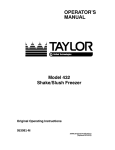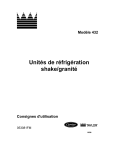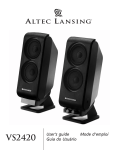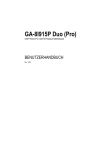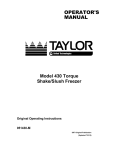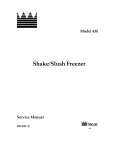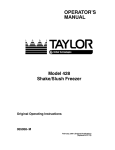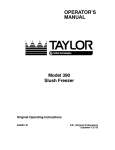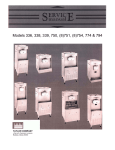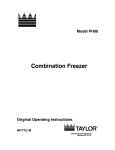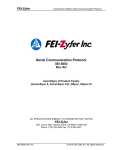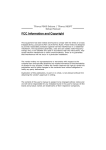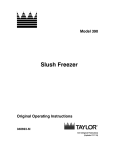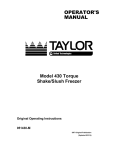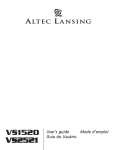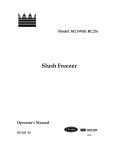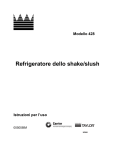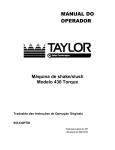Download 432 - YouNeedADrink.com
Transcript
Model 432 Shake/Slush Freezers Operating Instructions 053081- M 10/98 Complete this page for quick reference when service is required: Taylor Distributor: Address: Phone: Service: Parts: Date of Installation: Information found on the data label: Model Number: Serial Number: Electrical Specs: Voltage Cycle Phase Maximum Fuse Size: A Minimum Wire Ampacity: A E October, 1998 Taylor All rights reserved. 053081-M The word Taylor and the Crown design are registered trademarks in the United States of America and certain other countries. Taylor Company a division of Carrier Commercial Refrigeration, Inc. 750 N. Blackhawk Blvd. Rockton, IL 61072 Table of Contents To the Installer . . . . . . . . . . . . . . . . . . . . . . . . . . . . . . . . . . . . . . . . . . . . 1 Installer Safety . . . . . . . . . . . . . . . . . . . . . . . . . . . . . . . . . . . . . . . . . . . . . . . . . . . . . . . . 1 Site Preparation . . . . . . . . . . . . . . . . . . . . . . . . . . . . . . . . . . . . . . . . . . . . . . . . . . . . . . . 1 Air Cooled Units . . . . . . . . . . . . . . . . . . . . . . . . . . . . . . . . . . . . . . . . . . . . . . . . . . . . . . . 1 Electrical Connections . . . . . . . . . . . . . . . . . . . . . . . . . . . . . . . . . . . . . . . . . . . . . . . . . 2 Beater Rotation . . . . . . . . . . . . . . . . . . . . . . . . . . . . . . . . . . . . . . . . . . . . . . . . . . . . . . . 2 Refrigerant . . . . . . . . . . . . . . . . . . . . . . . . . . . . . . . . . . . . . . . . . . . . . . . . . . . . . . . . . . . 3 To the Operator . . . . . . . . . . . . . . . . . . . . . . . . . . . . . . . . . . . . . . . . . . . 4 Compressor Warranty Disclaimer . . . . . . . . . . . . . . . . . . . . . . . . . . . . . . . . . . . . . . . 4 Section 3 Safety . . . . . . . . . . . . . . . . . . . . . . . . . . . . . . . . . . . . . . . . . . . . . . . . . . . . 5 Section 4 Operator Parts Identification . . . . . . . . . . . . . . . . . . . . . . . . . . . . . . . 7 Model 432 . . . . . . . . . . . . . . . . . . . . . . . . . . . . . . . . . . . . . . . . . . . . . . . . . . . . . . . . . . . . 7 Beater Door Assembly . . . . . . . . . . . . . . . . . . . . . . . . . . . . . . . . . . . . . . . . . . . . . . . . . 8 Accessories . . . . . . . . . . . . . . . . . . . . . . . . . . . . . . . . . . . . . . . . . . . . . . . . . . . . . . . . . . 10 Important: To the Operator . . . . . . . . . . . . . . . . . . . . . . . . . . . . . . . . . 11 Control Switch (Item 1) . . . . . . . . . . . . . . . . . . . . . . . . . . . . . . . . . . . . . . . . . . . . . . . . . 11 Push--Button Switch (Item 2) . . . . . . . . . . . . . . . . . . . . . . . . . . . . . . . . . . . . . . . . . . . . 11 Display Light Switch (Item 3) . . . . . . . . . . . . . . . . . . . . . . . . . . . . . . . . . . . . . . . . . . . . 11 Indicator Light -- “Mix Out” (Item 4) . . . . . . . . . . . . . . . . . . . . . . . . . . . . . . . . . . . . . . 12 Indicator Light -- “Add Mix” (Item 5) . . . . . . . . . . . . . . . . . . . . . . . . . . . . . . . . . . . . . . 12 Viscosity Adjustment (Item 6) . . . . . . . . . . . . . . . . . . . . . . . . . . . . . . . . . . . . . . . . . . . 12 Operating Procedures . . . . . . . . . . . . . . . . . . . . . . . . . . . . . . . . . . . . . 13 Assembly . . . . . . . . . . . . . . . . . . . . . . . . . . . . . . . . . . . . . . . . . . . . . . . . . . . . . . . . . . . . 13 Sanitizing . . . . . . . . . . . . . . . . . . . . . . . . . . . . . . . . . . . . . . . . . . . . . . . . . . . . . . . . . . . . 17 Priming . . . . . . . . . . . . . . . . . . . . . . . . . . . . . . . . . . . . . . . . . . . . . . . . . . . . . . . . . . . . . . 18 Section 1 Section 2 Section 5 Section 6 Table of Contents Model 432 Table of Contents -- Page 2 Closing Procedure . . . . . . . . . . . . . . . . . . . . . . . . . . . . . . . . . . . . . . . . . . . . . . . . . . . . 18 Draining Product From The Freezing Cylinder . . . . . . . . . . . . . . . . . . . . . . . . . . . . 18 Rinsing . . . . . . . . . . . . . . . . . . . . . . . . . . . . . . . . . . . . . . . . . . . . . . . . . . . . . . . . . . . . . . 19 Cleaning . . . . . . . . . . . . . . . . . . . . . . . . . . . . . . . . . . . . . . . . . . . . . . . . . . . . . . . . . . . . . 19 Disassembly . . . . . . . . . . . . . . . . . . . . . . . . . . . . . . . . . . . . . . . . . . . . . . . . . . . . . . . . . . 19 Brush Cleaning . . . . . . . . . . . . . . . . . . . . . . . . . . . . . . . . . . . . . . . . . . . . . . . . . . . . . . . 20 Important: Operator Checklist . . . . . . . . . . . . . . . . . . . . . . . . . . . . . . 21 During Cleaning and Sanitizing: . . . . . . . . . . . . . . . . . . . . . . . . . . . . . . . . . . . . . . . . . 21 Troubleshooting Bacterial Count: . . . . . . . . . . . . . . . . . . . . . . . . . . . . . . . . . . . . . . . . 21 Regular Maintenance Checks: . . . . . . . . . . . . . . . . . . . . . . . . . . . . . . . . . . . . . . . . . . 21 Winter Storage . . . . . . . . . . . . . . . . . . . . . . . . . . . . . . . . . . . . . . . . . . . . . . . . . . . . . . . . 22 Section 8 Troubleshooting Guide . . . . . . . . . . . . . . . . . . . . . . . . . . . . . . . . . . . . 23 Section 9 Parts Replacement Schedule . . . . . . . . . . . . . . . . . . . . . . . . . . . . . . . 25 Section 10 Parts List . . . . . . . . . . . . . . . . . . . . . . . . . . . . . . . . . . . . . . . . . . . . . . . . . 26 Wiring Diagrams . . . . . . . . . . . . . . . . . . . . . . . . . . . . . . . . . . . . . . . . . . . . . . . . . . . . . . 31 Section 7 Note: Continuing research results in steady improvements; therefore, information in this manual is subject to change without notice. E October, 1998 Taylor All rights reserved. 053081-M The word Taylor and the Crown design are registered trademarks in the United States of America and certain other countries. Model 432 Taylor Company a division of Carrier Commercial Refrigeration, Inc. 750 N. Blackhawk Blvd. Rockton, IL 61072 Table of Contents Section 1 To the Installer The following are general installation instructions. For complete installation details, please see the check out card. This unit has many sharp edges that can cause severe injuries. Site Preparation Installer Safety Review the area the unit is to be installed in before uncrating the unit making sure that all possible hazards the user or equipment may come into have been addressed. In all areas of the world, equipment should be installed in accordance with existing local codes. Please contact your local authorities if you have any questions. For Indoor Use Only: This unit is designed to operate indoors, under normal ambient temperatures of 70_-75_F (21_-24_C). The freezer has successfully performed in high ambient temperatures of 104_(40_C) at reduced capacities. Care should be taken to ensure that all basic safety practices are followed during the installation and servicing activities related to the installation and service of Taylor equipment. S S S S This unit must NOT be installed in an area where a water jet or hose can be used. NEVER use a water jet or hose to rinse or clean the unit. Failure to follow this instruction may result in electrocution. Only authorized Taylor service personnel should perform installation and repairs on the equipment. Authorized service personnel should consult OSHA Standard 29CFRI910.147 or the applicable code of the local area for the industry standards on lockout/tagout procedures before beginning any installation or repairs. Authorized service personnel must ensure that the proper PPE is available and worn when required during installation and service. Authorized service personnel must remove all metal jewelry, rings, and watches before working on electrical equipment. This unit must be installed on a level surface to avoid the hazard of tipping. Extreme care should be taken in moving this equipment for any reason. Two or more persons are required to safely move this unit. Failure to comply may result in personal injury or equipment damage. Uncrate the unit and inspect it for damage. Report any damage to your Taylor Distributor. This piece of equipment is made in the USA and has USA sizes of hardware. All metric conversions are approximate and vary in size. The main power supply(s) to the freezer must be disconnected prior to performing any repairs. Failure to follow this instruction may result in personal injury or death from electrical shock or hazardous moving parts as well as poor performance or damage to the equipment. Air Cooled Units DO NOT obstruct air intake and discharge openings: A minimum of 6” (152 mm) on both sides and 0” on the back is required. Failure to follow this instruction may cause poor freezer performance and damage to the machine. Note: All repairs must be performed by an authorized Taylor Service Technician. 081208 Model 432 1 To the Installer Electrical Connections This unit must be plugged into a properly grounded receptacle. The cord and plug must be sized for 20 Amp usage. The voltage specifications are 208--230/60/1. Follow specifications listed on your data plate. S FOLLOW YOUR LOCAL ELECTRICAL CODES! S In the United States, this equipment is intended to be installed in accordance with the National Electrical Code (NEC), ANSI/NFPA 70--1987. The purpose of the NEC code is the practical safeguarding of persons and property from hazards arising from the use of electricity. This code contains provisions considered necessary for safety. Compliance therewith and proper maintenance will result in an installation essentially free from hazard! S In all other areas of the world, equipment should be installed in accordance with the existing local codes. Please contact your local authorities. Each unit requires one power supply for each data label on the unit. Check the data label on the freezer for fuse, circuit ampacity and other electrical specifications. Refer to the wiring diagram provided inside of the electrical box, for proper power connections. Stationary appliances which are not equipped with a power cord and a plug or another device to disconnect the appliance from the power source must have an all-pole disconnecting device with a contact gap of at least 3mm installed in the external installation. Appliances that are permanently connected to fixed wiring and for which leakage currents may exceed 10 mA, particularly when disconnected or not used for long periods, or during initial installation, shall have protective devices such as a GFI, to protect against the leakage of current, installed by the authorized personnel to the local codes. Supply cords used with this unit shall be oil-resistant, sheathed flexible cable not lighter than ordinary polychloroprene or other equivalent synthetic elastomer-sheathed cord (Code designation 60245 IEC 57) installed with the proper cord anchorage to relieve conductors from strain, including twisting, at the terminals and protect the insulation of the conductors from abrasion. Beater Rotation CAUTION: THIS EQUIPMENT MUST BE PROPERLY GROUNDED! FAILURE TO DO SO CAN RESULT IN SEVERE PERSONAL INJURY FROM ELECTRICAL SHOCK! Beater rotation must be clockwise as viewed looking into the freezing cylinder. Note: The following procedures must be performed by an authorized Taylor service technician. This unit is provided with an equipotential grounding lug that is to be properly attached to the rear of the frame by the authorized installer. The installation location is marked by the equipotential bonding symbol (5021 of IEC 60417-1) on both the removable panel and the equipments frame. To correct rotation on a single--phase unit, change the leads inside the beater motor. (Follow the diagram printed on motor.) 080911 To the Installer 2 Model 432 Refrigerant In consideration of our environment, Taylor proudly uses only earth friendly HFC refrigerants. The HFC refrigerant used in this unit is R404A. This refrigerant is generally considered non-toxic and non-flammable, with an Ozone Depleting Potential (ODP) of zero (0). Taylor reminds technicians to be cautious of government laws regarding refrigerant recovery, recycling, and reclaiming systems. If you have any questions regarding these laws, please contact the factory Service Department. However, any gas under pressure is potentially hazardous and must be handled with caution. NEVER fill any refrigerant cylinder completely with liquid. Filling the cylinder to approximately 80% will allow for normal expansion. WARNING: R404A refrigerant used in conjunction with polyolester oils is extremely moisture absorbent. When opening a refrigeration system, the maximum time the system is open must not exceed 15 minutes. Cap all open tubing to prevent humid air or water from being absorbed by the oil. Refrigerant liquid sprayed onto the skin may cause serious damage to tissue. Keep eyes and skin protected. If refrigerant burns should occur, flush immediately with cold water. If burns are severe, apply ice packs and contact a physician immediately. 080911 Model 432 3 To the Installer Section 2 To the Operator The freezer you have purchased has been carefully engineered and manufactured to give you dependable operation. The Taylor Model 432, when properly operated and cared for, will produce a consistent quality product. Like all mechanical products, they will require cleaning and maintenance. A minimum amount of care and attention is necessary if the operating procedures outlined in this manual are followed closely. The user is responsible for returning the product to the appropriate collection facility, as specified by your local code. For additional information regarding applicable local laws, please contact the municipal facility and/or local distributor. This Operator’s Manual should be read before operating or performing any maintenance on your equipment. Compressor Warranty Disclaimer The refrigeration compressor(s) on this machine are warranted for the term indicated on the warranty card accompanying this machine. However, due to the Montreal Protocol and the U.S. Clean Air Act Amendments of 1990, many new refrigerants are being tested and developed, thus seeking their way into the service industry. Some of these new refrigerants are being advertised as drop--in replacements for numerous applications. It should be noted that, in the event of ordinary service to this machine’s refrigeration system, only the refrigerant specified on the affixed data label should be used. The unauthorized use of alternate refrigerants will void your compressor warranty. It will be the owner’s responsibility to make this fact known to any technician he employs. Your Taylor freezer will NOT eventually compensate for and correct any errors during the set--up or filling operations. Thus, the initial assembly and priming procedures are of extreme importance. It is strongly recommended that personnel responsible for the equipment’s operation, both assembly and disassembly, sit down together and go through these procedures in order to be properly trained and to make sure that no misunderstandings exist. In the event you should require technical assistance, please contact your local authorized Taylor Distributor. Note: Warranty is valid only if the parts are authorized Taylor parts, purchased from an authorized Taylor Distributor, and the required service work is provided by an authorized Taylor service technician. Taylor reserves the right to deny warranty claims on equipment or parts if non--approved parts or refrigerant were installed in the machine, system modifications were performed beyond factory recommendations, or it is determined that the failure was caused by neglect or abuse. It should also be noted that Taylor does not warrant the refrigerant used in its equipment. For example, if the refrigerant is lost during the course of ordinary service to this machine, Taylor has no obligation to either supply or provide its replacement either at billable or unbillable terms. Taylor does have the obligation to recommend a suitable replacement if the original refrigerant is banned, obsoleted, or no longer available during the five year warranty of the compressor. Note: Constant research results in steady improvements; therefore, information in this manual is subject to change without notice. Taylor will continue to monitor the industry and test new alternates as they are being developed. Should a new alternate prove, through our testing, that it would be accepted as a drop--in replacement, then the above disclaimer would become null and void. To find out the current status of an alternate refrigerant as it relates to your compressor warranty, call the local Taylor Distributor or the Taylor Factory. Be prepared to provide the Model/Serial Number of the unit in question. If the crossed out wheeled bin symbol is affixed to this product, it signifies that this product is compliant with the EU Directive as well as other similar legislation in effect after August 13, 2005. Therefore, it must be collected separately after its use is completed, and cannot be disposed as unsorted municipal waste. 080623 To the Operator 4 Model 432 Section 3 Safety We at Taylor Company are concerned about the safety of the operator when he or she comes in contact with the freezer and its parts. Taylor has gone to extreme efforts to design and manufacture built--in safety features to protect both you and the service technician. As an example, warning labels have been attached to the freezer to further point out safety precautions to the operator. S S S IMPORTANT -- Failure to adhere to the following safety precautions may result in severe personal injury or death. Failure to comply with these warnings may damage the machine and its components. Component damage will result in part replacement expense and service repair expense. S S DO NOT operate the freezer without reading this Operator Manual. Failure to follow this instruction may result in equipment damage, poor freezer performance, health hazards, or personal injury. S This unit is provided with an equipotential grounding lug that is to be properly attached to the rear of the frame by the authorized installer. The installation location is marked by the equipotential bonding symbol (5021 of IEC 60417-1) on both the removable panel and the equipments frame. DO NOT use a water jet to clean or rinse the freezer. Failure to follow these instructions may result in serious electrical shock. DO NOT operate the freezer unless it is properly grounded. DO NOT operate the freezer with larger fuses than specified on the freezer data label. DO NOT attempt any repairs unless the main power supply to the freezer has been disconnected. Contact your local authorized Taylor Distributor for service. Stationary appliances which are not equipped with a power cord and a plug or another device to disconnect the appliance from the power source must have an all-pole disconnecting device with a contact gap of at least 3mm installed in the external installation. Appliances that are permanently connected to fixed wiring and for which leakage currents may exceed 10 mA, particularly when disconnected or not used for long periods, or during initial installation, shall have protective devices such as a GFI, to protect against the leakage of current, installed by the authorized personnel to the local codes. Supply cords used with this unit shall be oil-resistant, sheathed flexible cable not lighter than ordinary polychloroprene or other equivalent synthetic elastomer-sheathed cord (Code designation 60245 IEC 57) installed with the proper cord anchorage to relieve conductors from strain, including twisting, at the terminals and protect the insulation of the conductors from abrasion. Failure to follow these instructions may result in electrocution. Contact your local authorized Taylor Distributor for service. 080911 Model 432 5 Safety Cleaning and sanitizing schedules are governed by your state or local regulatory agencies and must be followed accordingly. Please refer to the cleaning section of this manual for the proper procedure to clean this unit. DO NOT allow untrained personnel to operate this machine. S DO NOT operate the freezer unless all service panels and access doors are restrained with screws. S DO NOT remove any internal operating parts (examples: freezer door, beater, scraper blades, etc.) unless all control switches are in the OFF position. Failure to follow these instructions may result in severe personal injury to fingers or hands from hazardous moving parts. S DO NOT obstruct air intake and discharge openings: A minimum of 6” (152 mm) on both sides and 0” on the back is required. Failure to follow this instruction may cause poor freezer performance and damage to the machine. This unit has many sharp edges that can cause severe injuries. S DO NOT put objects or fingers in the door spout. This may contaminate the product and cause severe personal injury from blade contact. S USE EXTREME CAUTION when removing the beater asssembly. The scraper blades are very sharp. For Indoor Use Only: This unit is designed to operate indoors, under normal ambient temperatures of 70_ 75_F (21_ - 24_C). The freezer has successfully performed in high ambient temperatures of 104_(40_C) at reduced capacities. NOISE LEVEL: Airborne noise emission does not exceed 78 dB(A) when measured at a distance of 1.0 meter from the surface of the machine and at a height of 1.6 meters from the floor. This freezer must be placed on a level surface. Failure to comply may result in personal injury or equipment damage. 080911 Safety 6 Model 432 Section 4 Operator Parts Identification Model 432 Item Description Part No. Item Description Part No. Stud--Nose Cone 5/16--18x5/16--18 013496 Panel--Front--Upper 052360 1 Cover A.--Hopper X52452 9 2 Panel--Rear 052363 10 *3 Panel--Side--Right--Louvered 052527 †10a Gasket--Insulator 052617 4 Panel--Front--Lower 052361 11 Bulb--Light--Fluorescent U--Shape 045445 5 Gasket--Base Pan 052377 12 Bracket--Light 052243 6 Tray A.--Drip X46848 13 Lens--Decorative Plate 052359 7 Shield--Splash 046851 14 Panel--Side--Left 052362 8 Pan--Drip 17--1/4” Long 027504 15 Shelf--Drip Tray 052065 *J8070000/Up -- Refer to Parts List at end of manual. †Not Shown. Model 432 7 Operator Parts Identification Beater Door Assembly Figure 1 090729 Operator Parts Identification 8 Model 432 Beater Door Assembly Parts Identification ITEM DESCRIPTION PART NO. ITEM DESCRIPTION PART NO. 1 DOOR A. - PARTIAL X39248 11 BEARING - GUIDE 014496 2 HANDLE A. DRAW X47384 12 CLIP - SCRAPER BLADE 046238 3 NUT-STUD 043666 13 BLADE - SCRAPER PLASTIC 046237 4 BUSTER - ICE 047735 14 014030 5 O-RING - 1" OD X .139 W 032504 GASKET - DOOR 5.109" ID X 5.630 6 VALVE DRAW - SLUSH - ICE BUSTER 047734 15 BEARING - FRONT 013116 16 BEATER A. - 4 QT. 1 PIN X49490 7 VALVE A. - HANDLE PIN X25929 17 SHAFT - BEATER 035418 8 O-RING - .291 OD X .080 W 018550 18 SEAL - DRIVE SHAFT 032560 9 ARM - TORQUE 052450 19 O-RING 7/8 OD X .139 W 025307 TORQUE ASSEMBLY X50382 10 081001 Model 432 9 Operator Parts Identification Accessories Item Description Part No. Item Description Part No 1 Kit A.--Tune Up X39969 6 Brush--Draw Valve 1--1/2” x 3” 014753 2 Brush--Mix Pump Body 3” x 7” 023316 7 Lubricant--Taylor 047518 3 Pail--Mix 10 Qt. 013163 8 Sanitizer -- Kay 5 (125 Packets) 041082 4 Brush--Double Ended 013072 *9 Panel A.--Air Guide X52521 5 Brush--Rear Bearing 1” x 2” x 14” 013071 *Prior to S/N J8070000. (Note: Optional Field Kit X52633 for S/N J8070000/Up.) 080508 Operator Parts Identification 10 Model 432 Section 5 Important: To the Operator Item Description 1 2 3 4 5 6 Switch--Toggle -- 3 PDT Switch--Push Button -- SPST Switch--Toggle--SPST -- 3/4 HP/250 V Light--Amber--Rect. -- 12 VDC -- MIX OUT Light--Amber--Rect. -- 12 VDC -- ADD MIX Viscosity Adjustment Control Switch (Item 1) The center position is “OFF”. The left position is “WASH”, which activates only the beater motor. The right position is “AUTO”, which activates the beater motor and the refrigeration system. Push--Button Switch (Item 2) If an overload condition occurs, the freezer will automatically stop operating. To properly reset the freezer, place the toggle switch in the “OFF” position. Wait two or three minutes; then press the push--button switch. Place the power switch in the “WASH” position and observe the freezer’s performance. Place the power switch in the “AUTO” position. Note: If the freezer is unplugged from the wall receptacle, it will be necessary to press the push--button switch for the freezer to operate once power is re--established. The following chart identifies the symbol definitions used on the operator switches. = The “ON/AUTO” button. Display Light Switch (Item 3) = The “OFF” button. The display light switch is located under the control channel. The left position is “OFF”. The right position is “ON”, and activates the display light. = The “WASH” button. Model 432 11 Important: To the Operator Indicator Light -- “Mix Out” (Item 4) Viscosity Adjustment (Item 6) A mix out indicating light is located on the front of the machine. When the light is flashing, it indicates that the hopper is empty and the mix supply needs replenishing. To prevent damage to the unit, refrigeration discontinues automatically when the mix out indicator lights illuminates. Refrigeration will restart 30 seconds after the mix supply is replenished. The viscosity (thickness) of the slush can be adjusted by turning the viscosity adjustment screw located under the control channel. Turn the viscosity adjustment screw clockwise for a thicker product, or counterclockwise for a thinner product. After making an adjustment, allow the refrigeration system to cycle 2 or 3 times to accurately evaluate the viscosity. Indicator Light -- “Add Mix” (Item 5) A mix level indicating light is located on the front of the machine. When the light is flashing, it indicates that the mix hopper has a low supply of product and should be refilled as soon as possible. Important: To the Operator 12 Model 432 Section 6 Operating Procedures The Model 432 freezer is designed to produce shake or slush product at the desired thickness. This unit has a 4 quart freezing cylinder. Install the drive shaft. Insert the beater drive shaft into the rear shell bearing and engage the square end firmly into the female socket of the drive unit. Be certain that the drive shaft fits into the drive coupling without binding. We begin our instructions at the point where we enter the store in the morning and find the parts disassembled and laid out to air dry from the previous night’s brush cleaning. These opening procedures will show you how to assemble these parts into the freezer, sanitize them, and prime the freezer with fresh mix in preparation to serve your first portion. If you are disassembling the machine for the first time or need information to get to this point in our instructions, turn to page 19, “Disassembly”, and start there. Assembly Note: When lubricating parts, use an approved food grade lubricant (example: Taylor Lube). Figure 2 Step 1 Lubricate the groove on the drive shaft and slide the o--ring in place. Lubricate the o--ring and shaft portion that comes in contact with the bearing. DO NOT lubricate the square end of the drive shaft. Lubricate the boot seal groove and slide the boot seal over the shaft and groove until it snaps into place. Fill the inside portion of the seal with 1/4” more lubricant and evenly lubricate the end of the seal that fits onto the rear shell bearing. Step 2 Install the beater assembly. First check the scraper blade for any nicks or signs of wear. If any nicks are present, replace the blade. If the blade is in good condition, place the clip over the blade and install the blade and clip on the beater assembly. Be sure the holes in the blade and the clip are securely positioned over the beater pin. Figure 1 Figure 3 Note: Do not install the boot seal inside out. Model 432 13 Operating Procedures Holding the beater securely, slide the beater into the freezing cylinder and align the hole at the rear of the beater with the flats on the end of the drive shaft. Slide the beater the remainder of the way into the freezing cylinder and over the end of the drive shaft. The beater assembly will not protrude beyond the front of the freezing cylinder. Figure 6 Step 5 Assemble the freezer door with the “Ice Buster” (door spout clearing device). To assemble the door with the ice buster, install the o--rings on the draw valve and lubricate. Figure 4 Step 3 Install the white plastic guide bearing on the short end of the torque rotor. Slide the o--ring into the groove on the long end of the torque rotor and lubricate the o--ring. Do not lubricate the guide bearing. Figure 7 Insert the draw valve into the door, leaving approximately half of the valve sticking out the top of the door. Figure 5 Step 4 Insert the torque rotor end with the guide bearing into the pilot hole in the center of the drive shaft. The hole in the torque rotor shaft should be rotated to the 12 o’clock position. Operating Procedures Figure 8 14 Model 432 Place the large rubber gasket into the groove on the back side of the freezer door. Slide the white, plastic front bearing onto the bearing hub, making certain that the flanged end of the bearing is resting against the freezer door. DO NOT lubricate the door gasket or front bearing. Rotate the draw valve so the flats on the top of the draw valve are perpendicular to the door face. Figure 9 Insert the ice buster through the door spout and into the slot located just above the lower o--ring. Figure 12 Step 6 Install the door on the four studs on the front of the freezing cylinder. Install the four handscrews on the door, and tighten them equally in a criss--cross manner. Figure 10 With the ice buster in place, rotate the draw valve to allow installation of the draw handle. This will lock the ice buster in place. Install the draw handle pin, and close the draw valve by moving the handle to the left. Figure 11 Model 432 Figure 13 15 Operating Procedures Step 9 Install the front drip tray and splash shield beneath the door spouts. Step 7 Position the torque arm by inserting it through the slot in the torque switch arm and down into the hole in the torque rotor which protrudes from the door. Verify proper installation by moving the torque rotor back and forth to be sure it moves freely and easily. Figure 16 Step 10 Lay the air/mix feed tube (optional) in the bottom of the mix hopper. Figure 14 Step 8 Install the front drip pans. Slide the long drip pans into the holes in the front panel. Figure 17 Figure 15 Operating Procedures Repeat these steps for the other side of the unit. 16 Model 432 Sanitizing Step 5 Place an empty mix pail beneath the door spout and move the draw handle to the right. Draw off all the sanitizing solution. When the sanitizer stops flowing from the door spout, move the draw handle to the left and place the control switch in the “OFF” position. Step 1 Prepare an approved 100 PPM sanitizing solution (examples: 2--1/2 gal. [9.5 liters] of Kay--5R or 2 gal. [7.6 liters] of Stera--SheenR). USE WARM WATER AND FOLLOW THE MANUFACTURER’S SPECIFICATIONS. Step 2 Pour the sanitizing solution into the hopper and allow it to flow into the freezing cylinder. Figure 20 Figure 18 Step 6 Stand the air/mix feed tube (optional) in the corner of the hopper. Step 3 While the solution is flowing into the freezing cylinder, brush clean the mix hopper, air/mix feed tube (optional) and mix inlet hole. Step 4 Place the power switch in the “WASH” position. This will agitate the sanitizing solution in the freezing cylinder. Allow the solution to agitate for five minutes. Figure 21 Figure 19 Model 432 Repeat these steps for the other side of the unit. 17 Operating Procedures Priming Note: To identify the viscosity adjustment screw, see illustration on page 11. Step 1 With a pail beneath the door spout, move the draw handle to the right. Pour two gallons (7.6 liters) of FRESH mix into the hopper and allow it to flow into the freezing cylinder. This will force out any remaining sanitizing solution. When full strength mix is flowing from the door spout, move the draw handle to the left. Step 4 Place the mix hopper cover in position. Periodically, during the day’s operation, check to be sure there is a sufficient amount of mix in the hopper. Step 2 When the mix has stopped bubbling down into the freezing cylinder, install the air/mix feed tube (optional) in the mix inlet hole with the hole side down. Figure 24 Repeat these steps for the other side of the unit. Figure 22 Step 3 Place the power switch in the “AUTO” position. When the unit cycles off, the product will be at serving viscosity. The viscosity (thickness) of the slush can be adjusted by turning the viscosity adjustment screw located under the control channel. Turn the viscosity adjustment screw clockwise for a thicker product, or counterclockwise for a thinner product. After making an adjustment, allow the refrigeration system to cycle 2 or 3 times to accurately evaluate the viscosity. Closing Procedure To disassemble this unit, the following items will be needed: S S S S Two cleaning pails Necessary brushes (provided with freezer) Cleaner Single service towels Draining Product From The Freezing Cylinder Step 1 Place the power switch in the “OFF” position as far ahead of cleaning time as possible to allow frozen product to soften for easier cleaning. Step 2 Raise the hopper cover. If the unit is equipped with an air/mix feed tube, take it to the sink for cleaning. Figure 23 Operating Procedures 18 Model 432 Cleaning Step 3 If local health codes permit the use of rerun, place a sanitized, NSF approved stainless steel rerun container beneath the door spout. Place the power switch in the “WASH” position and move the draw handle to the right. When all the product stops flowing from the door spout, move the draw handle to the left and place the power switch in the “OFF” position. Place the sanitized lid on the rerun container and place it in the walk--in cooler. Step 1 Prepare an approved 100 PPM cleaning solution (examples: 2--1/2 gal. [9.5 liters] of Kay--5R or 2 gal. [7.6 liters] of Stera--SheenR). USE WARM WATER AND FOLLOW THE MANUFACTURER’S SPECIFICATIONS. Step 2 Pour the cleaning solution into the hopper and allow it to flow into the freezing cylinder. Note: If local health codes DO NOT permit the use of rerun, the product must be discarded. Follow the instructions in the previous step, except drain the product into a mix pail and properly discard the mix. Step 3 While the solution is flowing into the freezing cylinder, brush--clean the mix hopper and mix inlet hole. ALWAYS FOLLOW LOCAL HEALTH CODES. Step 4 Place the power switch in the “WASH” position. This will agitate the cleaning solution in the freezing cylinder. Repeat these steps for the other side of the unit. Rinsing Step 5 Place an empty pail beneath the door spout and move the draw handle to the right. Draw off all the cleaning solution. When the solution stops flowing from the door spout, move the draw handle to the left, and place the power switch in the “OFF” position. Step 1 Pour two gallons (7.6 liters) of cool, clean water into the mix hopper. With the brushes provided, scrub the mix hopper and the mix inlet hole. Repeat these steps for the other side of the unit. Disassembly Step 1 BE SURE THE CONTROL SWITCH IS IN THE “OFF” POSITION. Step 2 Remove the handscrews, freezer door, beater assembly, torque rotor, scraper blade and drive shaft from the freezing cylinder. Take these parts to the sink for cleaning. Figure 25 Step 2 With a pail beneath the door spout, place the power switch in the “WASH” position and move the draw handle to the right. Drain all the rinse water from the freezing cylinder. When the rinse water stops flowing from the door spout, move the draw handle to the left and place the control switch in the “OFF” position. Step 3 Remove the front drip tray and the splash shield. Take these parts to the sink for cleaning. Repeat this procedure until the rinse water being drawn from the freezing cylinder is clear. Step 4 Remove the rear drip pans from the front panel. Note: If the drip pans are filled with an excessive amount of mix, it is an indication the drive shaft seals should be replaced or properly lubricated. Repeat these steps for the other side of the unit. Repeat these steps for the other side of the unit. 080911 Model 432 19 Operating Procedures Brush Cleaning Step 4 Thoroughly brush--clean all disassembled parts in the cleaning solution, making sure all lubricant and mix film is removed. Place all the cleaned parts on a clean, dry surface to air dry. Step 1 Prepare a sink with a cleaning solution (examples: Kay--5R or Stera--SheenR). USE WARM WATER AND FOLLOW THE MANUFACTURER’S SPECIFICATIONS. (If another approved cleaner is used, dilute according to label instructions. IMPORTANT: Follow the label directions. Too STRONG of a solution can cause parts damage, while too MILD of a solution will not provide adequate cleaning.) Make sure all brushes provided with the freezer are available for brush cleaning. Step 5 Return to the freezer with a small amount of cleaning solution. Brush--clean the rear shell bearing at the back of the freezing cylinder with the black bristle brush. Step 2 Remove the o--ring and seal from the drive shaft. Remove the o--ring and the bearing from the torque rotor. Step 3 Remove the draw valve, ice buster, front bearing, and gasket from the freezer door. Remove all o--rings. Figure 26 Note: To remove the o--ring, use a single service towel to grasp the o--ring. Apply pressure in an upward direction until the o--ring pops out of its groove. With the other hand, push the top of the o--ring forward until it rolls out of the groove and can be removed easily. Operating Procedures Step 6 Wipe clean all exterior surfaces of the freezer. Repeat these steps for the other side of the unit. 20 Model 432 Section 7 Important: Operator Checklist During Cleaning and Sanitizing: the rerun with fresh mix in a ratio of 50/50 during the day’s operation. j 6. On a designated day of the week, run the mix as low as feasible and discard after closing. This will break the rerun cycle and reduce the possibility of high bacteria and coliform counts. ALWAYS FOLLOW LOCAL HEALTH CODES. Cleaning and sanitizing schedules are governed by federal, state, or local regulatory agencies, and must be followed accordingly. If the unit has a “Standby mode”, it must not be used in lieu of proper cleaning and sanitizing procedures and frequencies set forth by the ruling health authority. The following check points should be stressed during the cleaning and sanitizing operations. j 7. Properly prepare the cleaning and sanitizing solutions. Read and follow label directions carefully. Too strong of a solution may damage the parts and too weak of a solution will not do an adequate job of cleaning or sanitizing. j 8. Temperature of mix in mix hopper and walk--in cooler should be below 40_F. (4.4_C.). Regular Maintenance Checks: CLEANING AND SANITIZING MUST BE PERFORMED DAILY. j 1. Replace scraper blades that are nicked, damaged or worn down. Before installing beater, be certain the scraper blade is properly attached. Troubleshooting Bacterial Count: j 2. Check rear shell bearing for signs of wear (excessive mix leakage in drip pan) and be certain it is properly cleaned. j 1. Thoroughly clean and sanitize machine regularly, including complete disassembly and brush cleaning. j 2. Use all brushes supplied for thorough cleaning. The brushes are specially designed to reach all mix passageways. j 3. Using a screwdriver and cloth towel, keep the rear shell bearing and the female square drive socket clean and free of lubricant and mix deposits. j 3. Use the white bristle brush to clean the mix feed tube, which extends from the hopper down to the rear of the freezing cylinder. j 4. Dispose of o--rings and seals if they are worn, torn, or fit too loosely, and replace with new. j 5. Follow all lubricating procedures as outlined in “Assembly”. j 4. Use the black bristle brush to thoroughly clean the rear shell bearing located at the rear of the freezing cylinder. Be sure to have a generous amount of cleaning solution on the brush. j 6. Check the condenser(s) for accumulation of dirt and lint. Dirty condensers will reduce the efficiency and capacity of the machine. Condensers should be cleaned monthly with a soft brush. Never use screwdrivers or other metal probes to clean between the fins. Note: For machines equipped with an air filter, it will be necessary to vacuum clean the filters on a monthly schedule. j 5. IF LOCAL HEALTH CODES PERMIT THE USE OF RERUN, make sure the mix rerun is stored in a sanitized, covered stainless steel container and used the following day. DO NOT prime the machine with rerun. When using rerun, skim off the foam and discard, then mix 080118 Model 432 21 Important: Operator Checklist Winter Storage Wrap detachable parts of the freezer such as beater, blades, drive shaft, and freezer door, and place in a protected dry place. Rubber trim parts and gaskets can be protected by wrapping with moisture--proof paper. All parts should be thoroughly cleaned of dried mix or lubrication accumulations which attract mice and other vermin. If the place of business is to be closed during the winter months, it is important to protect the freezer by following certain precautions, particularly if the building is to be left unheated and subject to freezing conditions. Disconnect the freezer from the main power source to prevent possible electrical damage. Your local Taylor Distributor can perform this service for you. Important: Operator Checklist 22 Model 432 Section 8 PROBLEM 1. No product being dispensed. 2. Unit will not operate in the “AUTO” or “WASH” mode. 3. No compressor operation in the “AUTO” mode. Model 432 Troubleshooting Guide PROBABLE CAUSE REMEDY PAGE REF. a. Control switch is in the “OFF” position. a. Place control switch in the “AUTO” position. 18 b. Improper mixing of product. b. Carefully follow directions for mixing product. --- c. Inadequate mix in hopper. c. Fill hopper with mix. 18 d. Product frozen-up in freezing cylinder. d. Adjust viscosity adjustment accordingly. 11 e. Unit out on reset. e. Place control switch in the “OFF” position. Press the push-button switch. Return control switch to “AUTO”. 11 f. Beater assembly is rotating counterclockwise. Control switch is not in “AUTO”. f. If the beater is rotating counterclockwise, call a service technician to correct the rotation. 1 g. Unit unplugged at wall receptacle. g. Plug in power cord. --- h. Tripped circuit breaker or blown fuse. h. Reset circuit breaker or replace fuse. --- a. Unit unplugged at wall receptacle. a. Plug in power cord. --- b. Tripped circuit breaker or blown fuse. b. Reset circuit breaker or replace fuse. --- c. Unit out on reset. c. Place the control switch in the “OFF” position. Press the push-button switch. Return control switch to “AUTO”. 11 a. Beater motor is out on overload. a. Place control switch in “OFF” position. Press the push-button switch. Return control switch to “AUTO”. 11 b. Condenser dirty A/C. b. Clean condenser monthly. 21 23 Troubleshooting Guide PROBLEM 4. Product too thick. 5. Product too thin. 6. Scored walls of freezing cylinder. 7. Excessive leakage into rear drip pan. 8. Excessive leakage from door spout. 9. Unable to remove drive shaft. Troubleshooting Guide PROBABLE CAUSE REMEDY PAGE REF. a. Inadequate mix in hopper. a. Fill hopper with mix. b. Improper mixing of product. b. Carefully follow directions for mixing product. c. The viscosity adjustment is set incorrectly. c. Adjust the viscosity control. 11 d. The torque arm is not installed. d. Install the torque arm. 16 a. Missing, incorrectly installed, or bad scraper blade. a. Install or replace scraper blade. 13 b. Improper mixing of product. b. Carefully follow directions for mixing product. --- c. The viscosity adjustment is set incorrectly. c. Adjust accordingly. d. Incorrect beater rotation. (Rotation must be clockwise.) d. Contact service technician. --- e. Dirty condensers. e. Clean regularly. 21 a. Broken pin on beater assembly. a. Repair or replace beater assembly. b. Front bearing worn or missing. b. Replace or install front bearing. 14 a. Improper or inadequate lubrication of drive shaft seal. a. Use correct lubricant (Taylor Lube) and follow lubrication procedures. 13 b. Bad or missing seal on drive shaft. b. Replace seal every 3 months. 25 c. Worn rear shell bearing. c. Contact service technician for replacement. a. Improper or inadequate lubrication of draw valve o-rings. a. Use correct lubricant (Taylor Lube) and follow lubrication procedures. 13 b. Bad or missing o-rings on draw valve. b. Replace o-rings every 3 months. 25 a. Lubrication on square end of drive shaft. a. Do not lubricate square end. Contact service technician for replacement. 13 b. Rounded corners of drive shaft, drive coupling, or both. b. Contact service technician to replace drive shaft, drive coupling, or both. 24 18 --- 11 --- --- --- Model 432 Section 9 PART DESCRIPTION Parts Replacement Schedule EVERY 3 MONTHS EVERY 4 MONTHS EVERY 6 MONTHS ANNUALLY QUANTITIES TO BE REPLACED Drive Shaft Seal X 2 Drive Shaft O-Ring X 2 Scraper Blade X 2 Freezer Door Gasket X 2 Front Bearing X 2 Guide Bearing X 2 Torque Rotor O-Ring X 2 Draw Valve O-Rings X 4 Black Bristle Brush - 1” x 2” Inspect & Replace if Necessary Maximum 1 White Bristle Brush 1-1/2” x 2” Inspect & Replace if Necessary Maximum 1 White Bristle Brush - 3” x 7” Inspect & Replace if Necessary Maximum 1 Model 432 25 Parts Replacement Schedule Parts List 047062 052450 065764-27 045443 045444 045445 052243 052244 013116 014496 032511 028992 028991 012864 X49490 046237 046238 015192 023862 051644 024329 039422 040322-003 040322-004 013071 013072 014753 023316 023396 ARM-TORQUE-432 BALLAST-FLUORESCENT +SOCKET-FLUORESCENT LAMP +CLIP-FLUORESCENT LAMP +BULB-LIGHT-FLUORESCENT-U SHAPE +BRACKET-LIGHT +PLATE-STOP-LIGHT BEARING-FRONT BEARING-GUIDE BEARING-REAR SHELL *PLASTIC* +GUIDE-DRIP SEAL +NUT-BRASS BEARING +WASHER-BEARING LOCK BEATER A.-4QT-1 PIN-SUPPORT +BLADE-SCRAPER-PLASTIC 9-13/16L +CLIP-SCRAPER BLADE 8.75 INCH BELT-V-4L510 (LONG) BELT-V-4L320 (SHORT) BLOCK-TERMINAL 2P .25 SPADE BLOCK-TERMINAL-5 POLE BLOCK-TERMINAL-2 POLE BLOCK-TERMINAL-PLUG 7P .2 SIP BLOCK-TERMINAL-PLUG 8P .2 SIP BRUSH-REAR BRG 1IN.DX2IN.LGX14 BRUSH-DOUBLE ENDED-PUMP&FEED T BRUSH-DRAW VALVE 1-1/2"OD X 3" BRUSH-MIX PUMP BODY-3"X7"WHITE BUSHING-SNAP 15/16 ID X 1-3/32 PART NUMBER ACCUMULATOR-COPPER 2"DIA 10"LG 432 STANDARD (043227F000 208-230V 60HZ 1PH) A/C-BRISTOL-R404A DESCRIPTION 2 1 1 1 1 1 1 2 2 2 2 2 2 2 2 2 1 1 1 2 1 2 2 1 1 1 1 2 1 QTY. 103 103 103 103 000 103 103 000 000 000 000 000 000 103 000 103 000 000 103 103 103 103 103 000 000 000 000 103 103 WARR. CLASS 26 RIGHT - FACING FRONT OF MACHINE LEFT - FACING FRONT OF MACHINE S/N K8068046 & UP - REPLACES X51800 GE #F27BXSPX41 REMARKS PARTS UPDATE Section 10 Parts List + Available Separately 080619 Model 432 + Available Separately Model 432 27 Parts List BUSHING-SNAP 11/16 ID X 7/8OD COMPRESSOR L61B562BBCB (BRISTOL) +CAPACITOR-RUN 30UF/370V +CAPACITOR-START-161-193UF/250V +RELAY-START-COMPRESSOR CONDENSER-AC-15LX14HX2.59T-3ROW COUPLING-3/8FS X 1/4FS COVER A.-HOPPER *432* DECAL-INST-CLN HPR DECAL-TROUBLESHOOT DECAL-DEC-TAYLOR DOMED DECAL-STATIC CLING 432 SET/5 DECAL-SWITCH CONTROL-OFF/ON DIAGRAM-WIRING*432* DOOR A.-PARTIAL *340-350-450 +BUSTER-ICE +HANDLE A.-DRAW-SLUSH-BLACK +PIN A.-VALVE HANDLE +VALVE-DRAW *SLUSH* ICE BUSTE +O-RING-1"OD X .139W DRYER-FILTER 3/8 X 3/8 SOLDER FASTENER-CLIP 10-32 U-TYPE CR3 FILTER-CORCOM 2VR1 GASKET-BASE PAN *432* +SCREW-10X7/16 UNSL TD HWH GASKET-DOOR 5.109"ID X 5.630OD GASKET-FRONT PANEL GEAR A.*REDUCER 4.92:1 SERVICE GUIDE A.-DRIP PAN *432* KIT A.-TUNE UP*SLUSH* BEARING-FRONT BEARING-GUIDE GASKET-DOOR 5.109"ID X 5.630 DESCRIPTION 010548 048727-27E 038487 031790 047067 046558 031791 X52452 019029 038374 053761 056780 042941 052145-27 X39248 047735 X47384 X25929 047734 032504 049154 064719 032567 052377 066234 014030 049031 015985-SER X52352 X39969 013116 014496 014030 PART NUMBER 1 1 1 1 1 1 1 2 1 1 1 1 1 1 2 2 2 2 2 4 1 4 2 1 11 2 2 2 2 2 2 2 2 QTY. 103 512 103 103 103 103 103 103 000 000 000 000 000 000 103 103 103 103 103 000 000 103 103 000 000 000 000 212 103 000 000 000 000 WARR. CLASS BASE PAN GASKET LIQUID LINE DRY/SOL 208-230V 60HZ 1PH LINE A.-DISCHARGE 208-230/60/1 208-230/60/1 208-230/60/1 208-230/60/1 REMARKS PARTS UPDATE + Available Separately Parts List 28 Model 432 O-RING-.291 ID X .080W O-RING-7/8 OD X .139W O-RING-1"OD X .139W SEAL-DRIVE SHAFT TOOL-O-RING REMOVAL-FREEZER LABEL-CAUTION-GRD-PERM-ENG/SP LABEL-WARN-COVER LABEL-SWITCH WASH/OFF/AUTO LIGHT-AMBER-RECT-12VDC-ADD MIX LIGHT-AMBER-RECT-12VDC-MIX OUT LUBRICANT-TAYLOR 4 OZ. MAN-OPER 432 MOTOR-1/4 HP MOTOR-FAN 50 WATT +FAN-5 BLADE 12" PUSH 22DEG CCW NUT-STUD *345-346-349-355* PAIL-MIX 10 QT. PAN-DRIP 17-1/4"LONG PANEL A.-UPPER FRONT *432 PANEL-FRONT *432* UPPER PANEL-FRONT *432* LOWER PANEL-REAR PANEL-SIDE *432*RIGHT*LOUVER PANEL-SIDE-LEFT *432* PCB A.-CONTROL *432* CHIP-SOFTWARE 432 TORQUE PCB A.-CONTROL-TORQUE PLATE A.-DEC *432* LIGHTED +LENS-DEC PLATE PLUG-HOLE 7/8 DIA. BLACK PROBE A.-MIX LOW PROBE A.-MIX OUT-SQUARE HOLE PULLEY-AK27-1/2 DESCRIPTION 018550 025307 032504 032560 048260-WHT 032164 051433 014502 052486-02 052487-02 047518 053081-M 014477-27 029770-27 049009 043666 013163 027504 X66410 052360 052361 052363 052527 066396 X52420-SER X40879 X53507-SER X52357 052359 010077 X52375 X41348 016190 PART NUMBER 000 000 000 000 000 000 000 000 103 103 000 000 212 103 103 103 000 103 103 103 103 103 103 212 103 212 103 103 000 103 103 103 1 1 1 1 1 2 2 2 1 1 1 2 2 2 WARR. CLASS 2 2 4 2 2 1 6 2 2 2 1 1 2 1 1 8 1 2 QTY. MIX LOW MIX OUT S/N K8041973 & UP REPLACLES 052362 CONTROL S/N K8068046 & UP - REPLACES 052360 S/N K8068045 & PRIOR REMARKS PARTS UPDATE + Available Separately Model 432 29 Parts List PULLEY-AK49 RELAY-3 POLE-20A-208/240 50/60 RELAY-SPDT-30A-240V RELAY-DPDT-20A-230V SANITIZER KAY-5 125 PACKETS SCREW-10-32X3/8 UNSL HWH SCREW-10X7/16 UNSL TD HWH SCREW-6-32X3/8 SLTD BINDER SCREW-10X3/8 SLOTTED HEX WSHR SCREW-10-32X1/2 SLTD TRUSS SCREW-10X3/8 SLOTTED HEX WSHR SHAFT-BEATER *341-2 RFB* +O-RING-7/8 OD X .139W +SEAL-DRIVE SHAFT SHELF-DRIP TRAY*382-384* SHELL A.-INSULATED *432* +STUD-NOSE CONE-5/16-18X5/16-18 +WASHER-FREEZER STUD *RD30* SHIELD-SPLASH *380/1* SHROUD-FAN SWITCH A.-TORQUE *432* +ARM-TORQUE-CONTROL BUSHING A.-TORQUE SPRING-TORQUE*RED* +BUSHING-ARM-TORQUE +BUSHING-PIVOT-TORQUE ARM BRACKET-ADJ.-TORQUE ROD-SWITCH SPRING-COMP. E-RING 5/16 SWITCH-LEVER-SPDT-1A-125V SWITCH-LEVER-SPDT-.1A-125V SWITCH-PUSHBUTTON-SPST DESCRIPTION 051394 012725-33 032607-27 026581-27 041082 039381 066234 002201 015582 037734 015582 035418 025307 032560 052065 X54801-SER 013496 049032 046851 039023 X52233 052232 X50399-SER 020232 049737 049739 052227 052231 025452 016422 062022 074821 016530 PART NUMBER 2 1 2 4 1 19 11 9 6 19 2 2 2 2 1 1 8 8 1 1 2 2 2 2 2 2 2 2 2 2 2 2 2 QTY. 103 103 103 103 000 000 000 000 000 000 000 103 000 000 103 512 103 103 103 103 103 103 103 103 103 103 103 103 103 000 103 103 103 WARR. CLASS COMPRESSOR CONTACTOR (PRIMARY) BEATER MOTOR LATCHING/COMPRESSOR RELAY REMARKS PARTS UPDATE + Available Separately Parts List 30 Model 432 039423 048727-33E 052145-33 COMPRESSOR L63B562DBLB DIAGRAM-WIRING *432* PART NUMBER 048230 012626 017184 X50382 018550 X46848 020059 003949 015176-9 053565 022665 046365 050900 043449-27 044982-27 PART NUMBER BLOCK-TERMINAL 3P L1,L2,L A/C-BRISTOL-R404A 3 PHASE (043233F000 208-230V 60HZ 3PH) DESCRIPTION SWITCH-PRESSURE 440 PSI-SOLDER SWITCH-TOGGLE-SPST 3/4HP/250V SWITCH-TOGGLE-3PDT TORQUE A. *430* +O-RING-.291 ID X .080W TRAY A.-DRIP *383/384/432 TUBE-CAPILLARY-9 FEET +TEE-1/4S COPPER TUBE-FEED-NON REVERS 3/8 HOLE VALVE-ACCESS-1/4MFL X 3/8ODSDR VALVE-EPR 1/4S VALVE-EXP-AUTO-1/4S X1/4 FPT +BOOT-VALVE-EXPANSION VALVE-SOLENOID VALVE-SOLENOID DESCRIPTION 1 1 1 QTY. 1 1 2 2 2 1 2 2 2 2 2 2 2 2 2 QTY. 000 512 103 WARR. CLASS 103 103 103 000 000 103 103 103 103 103 103 103 000 103 103 WARR. CLASS LIQUID LINE SUCTION LINE REMARKS LIGHT WASH/OFF/AUTO REMARKS PARTS UPDATE PARTS UPDATE Model 432 052145--27 5/08 Model 432 052145--33 5/08 Model 432 052145--40 4/08





































